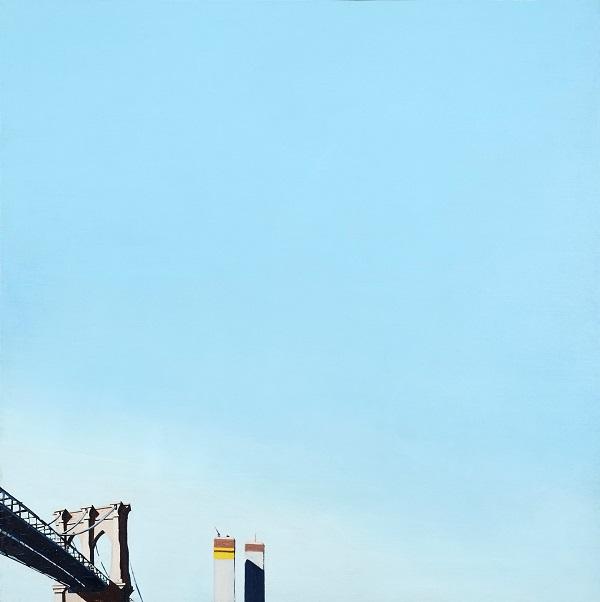Make a donation to the museum
Brooklyn Artist’s Painting Captures the Metamorphosis of the Twin Towers
Brooklyn Artist’s Painting Captures the Metamorphosis of the Twin Towers

Artist Ken Rush’s longtime fascination with the New York skyline inspired a series of works that he refers to as his “sky paintings,” one of which has been acquired by the 9/11 Memorial Museum.
Like other paintings in the series, “The World Trade Center and the Brooklyn Bridge” captures a glimpse of the city’s downtown horizon—in this case the almost completed Twin Towers and Gothic masonry tower of the nearby Brooklyn Bridge.
Rush has been captivated by the architectural monumentality of New York’s skyline since he was a boy growing up in Westchester County, New York. Born in 1948, Rush would make frequent excursions to Manhattan throughout the 1950s and 60s, including trips with his father to work.
Rush discovered his love of painting when he was a 16-year-old student at the Taft School in Connecticut. By 1971 he had graduated from Syracuse University with a degree in fine arts and was relocating to Brooklyn on a painting fellowship he’d received from college.
During this time, he began his “sky paintings” series, which included the piece donated to the 9/11 Memorial Museum. The painting captures only the upper floors of the newly erected Twin Towers, a portion of the Brooklyn Bridge, and a vast blue sky. Rush omitted the rest of the built skyline, channeling an admiration for minimalism he acquired in college. He says he viewed the towers as “minimalist sculptures” and “profound cubes that occupied space.”
By the time he painted the Twin Towers in 1971, they had reached their final height of 110 stories but were still not finished. In the painting, tarps can be seen covering the uppermost floors, where construction crews were spraying asbestos.
Rush sought to capture the towers in the unique stage of soon-to-be fixtures of the skyline. He likened this period of construction to the transformation of a caterpillar into a butterfly; tarps were being removed to reveal the skyscrapers’ finished steel, just as a caterpillar sheds its old skin to reveal a harder skin called a chrysalis.
“I think it captures my 21-year-old enthusiasm and love of the city,” Rush wrote of the work.
The painting first came to the attention of the Museum after the institution’s executive vice president of community and government affairs spotted a print of the work in Rush’s Sackett Street studio. The two men proceeded to talk outside the studio, which led to an invitation for Museum Collections staff to meet Rush to see the original artwork and learn about its genesis.
Alexandra Drakakis, a curator at the 9/11 Memorial Museum, described the intricate, well-composed painting as “documentary and lyrical, personal and universal, of its time and prescient of the icons that the Twin Towers would become.”
More artworks can be found Inside the Collection, and visitors are encouraged to submit their own works of art relating to 9/11 to the Museum’s Artists Registry.
By 9/11 Memorial Staff
Previous Post
Recap: "The Targeter: How to Hunt Terrorists"

Last week, Nada Bakos spoke about her time as a former CIA analyst and targeting officer in a public program at the 9/11 Memorial Museum.
Next Post
On View: Jon Richard Grabowksi’s Daily Planner

Filled with notes, schedules, and philosophical thoughts, Jon Richard Grabowski’s daily planner documents everything from the feelings of everyday life to his reflections on what it means to live. Grabowski’s planner is on view in the Museum’s In Memoriam gallery.